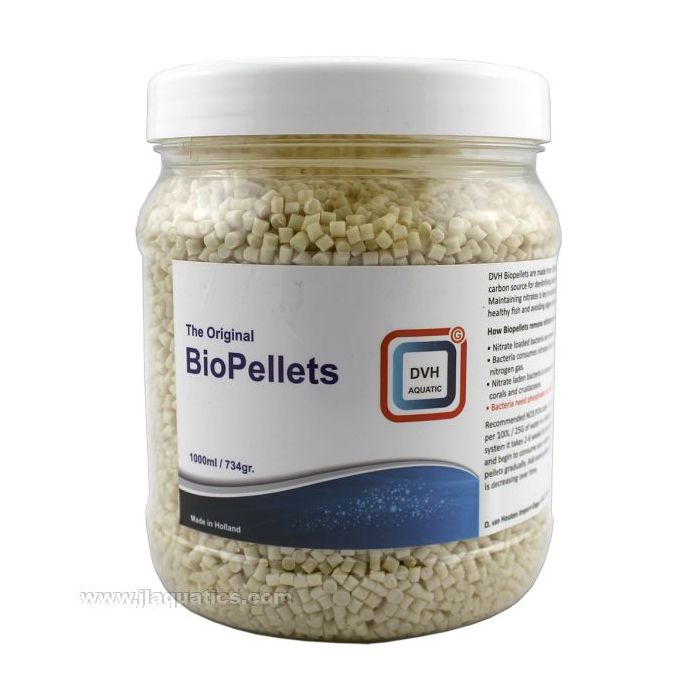DVH NP Reducing Biopellets (1000ml)
We provide, as first in the world - a novel filter media entitled NP-reducing BioPellets to the professional aquarium industry including public aquaria, zoos and aquaculture facilities.
This product has been developed for (professional) aquarists who want to supply their aquarium inhabitants with large quantities of feeds without negatively affecting water quality. The husbandry of marine species which can require large amounts of nutrition has made a crucial step forward with this new product. Examples of such species are Anthias fish, soft corals such as Dendronephthya sp. and filter feeders such as sea squirts.
The positive effects of NP-reducing BioPellets on water quality are based on the principle of immobilization. Waste products from the water, mainly nitrate and phosphate, are converted into bacteria. This keeps the aquarium water clean. The new formula NP-reducing BioPellets are composed of 100% pure biologically degradable polymers that can be placed in a fluidized filter or filter canister. The pellets will allow aerobic growth of bacteria which consequently will consume nitrate and phosphate simultaneously. The bacteria will use up the carbon from the BioPellets, whilst nitrogen and phosphorus are taken from the water as nitrate and (ortho)phosphate. This conversion of organic BioPellets (together with inorganic nitrogen and phosphorus) into microbial biomass is called immobilization. In addition, anaerobic layers will develop, resulting in additional denitrification. The surplus of bacteria will be consumed by filter and suspension feeding organisms such as sponges and corals, or skimmed off by a protein skimmer.
On average this "solid vodka method" takes 2-4 weeks to give rise to sufficient bacteria to allow nitrate and phosphate levels to drop. The main advantage of this method over using Vodka or sugar as a carbon source is that NP-reducing BioPellets stimulate local growth of bacteria in a filter compartment, instead of all over in the aquarium where they may clog up pipes and hoses. They also prevent the growth of cyanobacteria, as the bacteria growing on NP-reducing BioPellets will compete with these phototrophic nuisance microbes. Finally, NP-reducing BioPellets will save the aquarist a lot of time, as no daily dosages of carbon are required.
How it Works
NP-reducing BioPellets are consumed by bacteria, which is why new pellets need to be added every 6-12 months to compensate for digested substrate. This can be seen during inspection of the filter or when you measure a increase of nitrates. These figures however depend on aquarium conditions and are strongly influenced by feeding regimes and livestock.
Taking regular measurements of both nitrate and phosphate levels in the aquarium is recommended, after which dosages may be increased or decreased. Of Note, NP-reducing BioPellets consist of a higher molecular mass than most competing products resulting in a longer filter retention time and thus requires less frequent refill then other low molecular weight products which are currently being marketed. We suggest placing the outlet of the pellet filter in front of a protein skimmer, to limit the amount of bacteria entering the system. This has the additional benefit of increased gas exchange (CO2-removal and O2-addition). The pellets should never be used without sufficient aeration, as this may lead to low oxygen and pH levels, especially during night time. Proper aeration can be established with air pumps and protein skimmers.
The NP-reducing BioPellets will allow more feeding and thus more livestock, however, when heavy feeding is required, it is recommended to combine the pellets with standard phosphate adsorbents. The reason for this is that most aquarium feeds contain higher levels of phosphate than is consumed by bacteria, fish and invertebrates, when compared to nitrogen. Some phosphate adsorbents however deplete alkalinity and may reduce pH. Using phosphate adsorbent media based on iron hydroxide does not have this disadvantage.


















